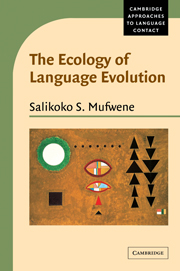Book contents
- Frontmatter
- Contents
- List of illustrations
- Preface
- Acknowledgments
- 1 Introduction
- 2 The Founder Principle in the development of creoles
- 3 The development of American Englishes: factoring contact in and the social bias out
- 4 The legitimate and illegitimate offspring of English
- 5 What research on the development of creoles can contribute to genetic linguistics
- 6 Language contact, evolution, and death: how ecology rolls the dice
- 7 Past and recent population movements in Africa: their impact on its linguistic landscape
- 8 Conclusions: the big picture
- Notes
- References
- Author index
- Subject index
7 - Past and recent population movements in Africa: their impact on its linguistic landscape
Published online by Cambridge University Press: 18 December 2009
- Frontmatter
- Contents
- List of illustrations
- Preface
- Acknowledgments
- 1 Introduction
- 2 The Founder Principle in the development of creoles
- 3 The development of American Englishes: factoring contact in and the social bias out
- 4 The legitimate and illegitimate offspring of English
- 5 What research on the development of creoles can contribute to genetic linguistics
- 6 Language contact, evolution, and death: how ecology rolls the dice
- 7 Past and recent population movements in Africa: their impact on its linguistic landscape
- 8 Conclusions: the big picture
- Notes
- References
- Author index
- Subject index
Summary
The following two themes are among the most central to this book: (i) language evolution involves not only the structural changes undergone by a language, possibly also its speciation into offspring varieties, but also matters having to do with its vitality, viz., whether it thrives, dies, or is endangered; (ii) some of the external ecological conditions which determine evolutionary trajectory also affect the vitality of a language in any of the senses stated above. In this chapter, focusing on Africa, I discuss the differential role of external ecology in determining the dispersal and speciation of some languages and the direction of their vitality. In the latter respect, I return to the distinction between exploitation and settlement colonization styles explained in chapter 1, and I highlight how differently they bear on social dynamics of languages. I show that in some polities such as South Africa, where the styles overlapped, their respective linguistic consequences can also be identified.
Chronologically, I approach the subject matter retrogressively, starting with the most recent and better understood events and moving step by step back to the distant past, arguing that basically the same evolutionary processes have been repeated over time. We can learn from the present to make sense of the past.
Preliminaries
Diverse consequences of language contact
African geolinguistics has been marked by quite a spectrum of contact phenomena. Most obvious are perhaps cases where some languages more indigenous to a region, such as those of the Pygmies and the Khoisans, have been driven to extinction by the Bantu dispersal into their territories.
- Type
- Chapter
- Information
- The Ecology of Language Evolution , pp. 167 - 191Publisher: Cambridge University PressPrint publication year: 2001

